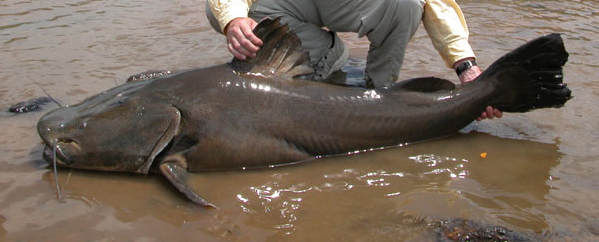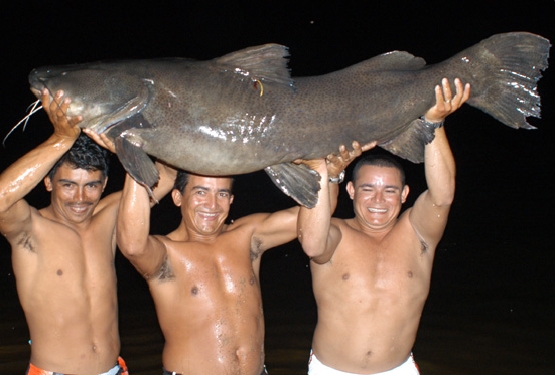[email protected] | 866-832-2987
Jaú
The Amazon’s Heaviest Deep-Water Predator
Jaú
The Amazon’s Heaviest Deep-Water Predator
Guide
The jaú, or pacamão, is one of the largest freshwater catfish in South America—and a true heavyweight of the Amazon basin. Found lurking in the deepest pools, channels, and riverbed drop-offs, this hulking predator is a challenge to locate and land, but a thrilling reward for those targeting Amazon giants. With its broad head, thick body, and incredible power, the jaú has earned a reputation among catfish anglers as one of the toughest battles in Amazon fishing.
Unlike the more mobile Piraíba, the jaú is a homebody—preferring well-defined territory near underwater structures like rocks, ledges, or submerged timber. Although primarily nocturnal, it can feed during the day, especially in fast-flowing sections of deep rivers or waterfalls. Targeting jaú requires patience, strength, and specialized gear—but when it takes your bait, you’ll know instantly that you’ve hooked into something formidable.
Interesting Facts & Notes
The jaú is considered the most “trunked” (short-bodied and thick) of all the giant Amazon catfish.
Reaches up to 150 lbs.
Unlike the migratory Piraíba, jaú are more sedentary and can often be found in the same deep holes year-round.
Juveniles tend to inhabit slower-moving areas but still display voracious predatory behavior.
Where to Catch
You can pursue jaú on these Acute Angling trips:
Quick Facts
| Attribute | Description |
|---|---|
| Scientific Name | Zungaro zungaro (Humboldt, 1821) |
| Common Names | Jaú, Pacamão |
| Size Range | Commonly 10-15 lbs; can exceed 115 lbs in optimal habitats |
| Region | Amazon Basin, major tributaries and deep rivers |
| Habitat | Deep holes, river channels, and rocky-bottomed falls or ledges |
| Behavior | Remains near structure, rocky bottoms, and faster currents |
| Coloration | Dark grey to black on the back; lighter underside; thick, rounded body |
| Aggression | Moderate to high – explosive power when hooked |
| Feeding Habits | Carnivorous; prefers fish but will eat crustaceans and other prey |
| Gamefish Status | Top-tier Amazon trophy catfish |

Physical Appearance
The jaú is known for its short, thick body and broad head—traits that distinguish it from other Amazon catfish. It has small eyes, a wide mouth, and strong jaws equipped for crushing prey. The dorsal and pectoral fins are large and robust, while the adipose fin is extended. Its skin is dark, often nearly black on top, fading to lighter tones on the belly.
How to Identify
Broad head and trunk-like body
Very dark coloration, often black or dark brown
Smaller eyes and shorter barbels compared to Piraíba
Rounded tail lobes and thick dorsal ridge
Fishing Tactics: How to Catch Jaú
Recommended Techniques
Jaú fishing is a bottom-game affair. The best results come from anchoring over deep holes and presenting large natural baits directly on the bottom. These fish tend to hold close to structure and rarely roam far, so precise placement matters. Night fishing is often most productive, though daytime strikes are common in turbulent zones.
Use large chunks or whole baitfish.
Target rocky ledges, riverbeds with debris, or the plunge pool below a waterfall.
Drop baits with heavy sinkers to hold position in swift current.
Wait patiently—jaú are deliberate strikers but hard to stop once hooked.
Suggested Gear
Rod and Reel: Heavy-duty baitcasting or conventional gear
Line: 100–150 lb braided main line
Hooks: 8/0 to 12/0 circle hooks
Sinkers: 8 oz to 2 lbs depending on current
Related Reading

Join the Adventure
Ready to hook into one of the Amazon’s toughest predators? Join us for a deep-water catfishing adventure where the jaú lurks below.
Contact us today:
📞 (866) 832-2987
References
Zeinad, A. K. & Prado, R. A. (2012). Peixes fluviais do Brasil: espécies esportivas.
Lundberg, J.G. & Littmann, M.W. (2003). Systematics of Giant South American Catfishes.
Santos, G.M. et al. (2006). Peixes comerciais de Manaus.
Goulding, M. (1980, 1981). The Fishes and the Forest; Amazon—The Flooded Forest.
Melo, M.R.S. et al. (2005). Ichthyofauna of the Madeira River Basin.
